Spacetime Before Einstein
On this page:
Classical Antiquity
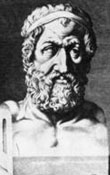
Zeno
What are space and time? Do they exist absolutely, or only relative to matter? Do they constitute the fixed background or stage upon which the drama of life is played out — or do they themselves also take part in the action? Such questions are as old as philosophy itself.
The Stoic philosopher Zeno of Citium (344-262 BCE, not to be confused with the earlier Zeno of Elea, author of Zeno's paradoxes) held that space and time were unreal since they could neither act nor be acted upon by matter. Such arguments were once considered purely metaphysical. If so, then Gravity Probe B proves that even metaphysical propositions can be tested by experiment! It would be hard to imagine a more direct demonstration that spacetime acts on matter than the geodetic effect (warped spacetime twists a spinning gyroscope), or a more convincing proof that matter acts back on spacetime than the frame-dragging effect (the spinning earth pulls spacetime around with it).

Archytas
Zeno's was an extreme version of the relational view of space (space exists only insofar as it is related to matter). In fact he taught that the concept of "empty space" was a contradiction in terms, since if space were truly empty it would be nothing and hence nonexistent. The opposite or absolutist view, that space does exist independently of matter, can be traced back to Leucippus of Abdera (active c. 450 BCE), the first of the Greek atomists (later the Epicureans), who introduced the concept of a pre-existing void as the "emptiness between atoms". The earliest surviving statement of the absolutist view has been attributed by Max Jammer (in Concepts of Space, 1954) to the Pythagorean philosopher Archytas (428-347 BCE): "Since everything which is moved is moved into a certain place, it is plain that the place where the thing moving or being moved shall be, must exist first."

Aristotle
Aristotle (384-322 BCE) constructed a careful and meticulous hybrid of the absolute and relational views. He was rather dismissive of his forbears, writing (in Book IV of the the Physics): "We encounter difficulties when we attempt to say what exactly the 'place' of a thing is ... Nor have my precursors laid anything down, or even formulated any questions, on this subject." He accepted arguments similar to that of Archytas, but was deeply unhappy with the atomistic idea of void, "since no preference can be given to one line of motion more than to another, inasmuch as the void, as such, is incapable of differentiation ... how [then] can there be any natural movement in the undifferentiated limitless void?" To get around this difficulty Aristotle developed the clever idea that space is defined by that which contains it. He was led in this way to his influential picture of a cosmos whose frame of reference is defined by the firmament of fixed stars above and the center of the earth below: "The center of the universe and the inner surface of the revolving heavens constitute the supreme 'below' and the supreme 'above'; the former being absolutely stable, and the latter constant in its position as a whole".
Late Antiquity to the Middle Ages
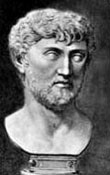
Lucretius
The nature of time as well as space was eagerly debated in this way by the ancients. The Epicurean philosopher Lucretius (c. 99-55 BCE) may have been the first to argue explicitly for a relational view of time, writing in The Nature of the Universe that: "Time by itself does not exist ... It must not be claimed that anyone can sense time by itself apart from the movement of things."

Ptolemy
Claudius Ptolemy (c. 85-165) essentially elaborated on Aristotle's system, using only circular motions and uniform speeds so as to "save the phenomena" in the face of increasingly accurate observations. The way in which he did this points up the absolute, as opposed to relational aspect of Aristotle's thinking, which anticipates Mach's principle only insofar as the "firmament of fixed stars" or the "center of the earth" can be regarded as material. Adopting an earlier idea of Hipparchus, Ptolemy first dislodged the center of the sun's "orbit" from the center of the earth ("eccentricity"). Later he added planetary "deferents", "epicycles" and finally "equants" — all preferred points or curves in empty space (some of them even with their own motions). He may have intended such "void points" to have definite positions or motions relative to a kind of divine matter permeating the void, for he wrote (in the Almagest): "The first cause of the first motion of the universe, if one considers it simply, can be thought of as an invisible and motionless deity." If so, Ptolemy anticipated Newton, who would refer to absolute space many centuries later (in the Opticks) as the "Sensorium" of God.
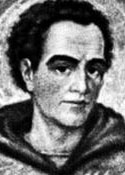
St. Augustine
Saint Augustine (354-430) put a theological twist on Lucretius' argument for the relational nature of time in his Confessions, emphasizing that "God created the world with time, not in time". Time came into existence along with matter, in other words — a viewpoint that interestingly foreshadows the one held by big-bang cosmologists today.
Aristotle's views reigned supreme throughout most of this period, but were challenged by occasional intrepid freethinkers such as John Philoponus (c. 490-570), who argued for a more purely absolute picture and reacted in particular against the idea that space is somehow defined by that which contains it: "Place is not the adjacent part of the surrounding body ... It is a given interval, measurable in three dimensions; it is distinct from the bodies in it, and is, by its very nature, incorporeal. In other words, it is the dimensions alone, devoid of any body."
The Scientific Revolution

Copernicus
Nicolaus Copernicus (1473-1543) relocated the center of Aristotle's universe from the earth to the sun. This relocation was, however, not so daring as often thought, for Hipparchus and Ptolemy had already moved the sun's "orbit" away from the center of the earth (by introducing "eccentricity"). As Copernicus himself noted near the beginning of De Revolutionibus: "Nothing prevents the earth from moving ... For, it is not the center of all the revolutions." Furthermore, although he re-centered the cosmos kinematically on the sun, Copernicus did not attach space dynamically to the rest frame of the sun or any other body, but followed Aristotle in associating it metaphysically with the "sphere of the fixed stars", which (he wrote): "contains itself and everything, and is therefore immovable. It is unquestionably the place of the universe, to which the motion and position of all the other heavenly bodies are compared".

Kepler
Fifty years later, astronomical observations could no longer be reconciled with the notion of rigid planetary spheres, leading Johannes Kepler (1571-1630) to declare: "From henceforth the planets follow their paths through the ether like the birds in the air. We must therefore philosophize about these things differently". Thoughts such as these led him to the radical idea of attaching the rest frame of space to physical bodies rather than metaphysical constructs (he conceived of forces extending outward from the sun and sweeping the planets along in their orbits). The laws of planetary motion that he subsequently derived have been characterized by Julian Barbour in The Discovery of Dynamics (1989) as a "pre-Machian triumph of Mach's Principle".

Galileo

Descartes
A subtle but similar shift in thinking affected Galilei Galileo (1564-1642). Rather than identifying the fixed stars with the rest frame of space in an abstract sense, he asserted (in the Dialogo) that they are physically at rest in space: "The fixed stars (which are so many suns) agree with our sun in enjoying perpetual rest". However, Galileo did not inquire further as to how this state of "rest" might be defined, and it appears that he rather unconsciously adopted an absolutist view of space. In fact he was the first to use the actual term "absolute motion", in his theory of the tides. Réné Descartes (1596-1650) believed implicitly in absolute space as well, and used the concept to arrive at something very similar to Newton's eventual first law of motion. After learning of Galileo's trial by the Inquisition, however, he put off publishing his results by more than a decade and prefaced them (in the Principia Philosophiae) by a disclaimer stating that all motion was, after all, relative! He may have been the first to hold both the absolutist and relational views at the same time.
Newton's Bucket

Newton

Leibniz
Isaac Newton (1643-1727) was unhappy with this inconsistency and complained (in De Gravitatione) that if all motion was really relative as Descartes said, then "it follows that a moving body has no determinate velocity and no definite line in which it moves". It was partly in order to remove any such confusion that he was moved to express himself so categorically in these famous lines from the Principia: "Absolute, true and mathematical time, of itself and from its own nature, flows equably without relation to anything external ... absolute space, in its own nature, without relation to anything external, remains always similar and immoveable." He added that the existence of absolute space could be demonstrated by hanging a bucket of water from a rope and spinning it, as shown in the figure below.
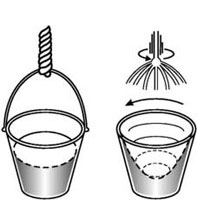
Drawing of Newton's Bucket
The fact that the water's surface gradually assumed a concave shape showed that it was spinning with respect to something; how else would it know what to do? Proof of the reality of space, in other words, could be found in the inertia of matter. Newton's most formidable relational critic was the mathematician and philosopher Gottfried Wilhelm Leibniz (1646-1716), who retorted in a debate with Newton's disciple Samuel Clarke that "space is nothing else but an order of the existence of things, observed as existing together; and therefore the fiction of a material finite universe, moving forward in an infinite empty space, cannot be admitted ... Such an action would be without any design in it: it would be working without doing any thing ... There would happen no change, which could be observed by person whatsoever".

Berkeley
An even more explicit statement of the relational view came from the philosophical "father of idealism", Bishop George Berkeley (1685-1753), who wrote (in De Motu) that in empty space it would not even be possible to conceive, for example, of two globes orbiting around a common center (for an observer moving along with the globes would see nothing changing at all), but "Suppose that the sky of fixed stars is created; suddenly from the conception of the approach of the globes to different parts of the sky the motion will be conceived."
Mach's Principle
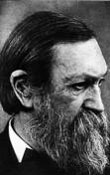
Mach
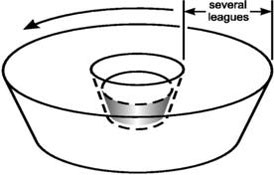
Mach and his modified bucket experiment
If Newton's was the definitive statement of the absolutist view of space, then his most notorious relational counterpart was Ernst Mach (1838-1916), who addressed himself directly to Newton's bucket argument, writing in The Science of Mechanics (1883): "No one is competent to say how the experiment would turn out if the sides of the vessel increased in thickness and mass until they were ultimately several leagues thick". A sufficiently massive bucket, in other words, might carry the local inertial frame of the water around with it, leaving the water's surface flat.
Mach's principle, as this idea has come to be known, has proved stubbornly difficult to formulate in a precise physical way, and even more difficult to test experimentally. At one conference on this subject in Tübingen in 1993, leading experts discussed at least 21 different versions of "Mach's principle" in the scientific literature, some of them mutually contradictory. It is probably for this reason that Mach's relational ideas have proved less fruitful than inspirational in physics. Nevertheless they led to some fascinating experimental investigations, even before Einstein's time. In 1894 Immanuel Friedlaender (1871-1948) looked for evidence that a heavy rotating millstone could exert a Mach-type force on a sensitive torsion balance, but confessed (in Absolute or Relative Motion?) that he could find no definite results either way. The better-known physicist August Föppl (1854-1924) looked for a coupling between the spin of the earth and that of a pair of heavy flywheels whose rotation axis could be aligned along either lines of latitude or longitude. He too found nothing, but noted that his experimental precision was limited to about two percent. Föppl published this work in 1904, one year before Einstein's theory of special relativity.
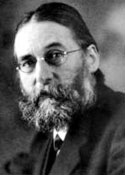
Föppl
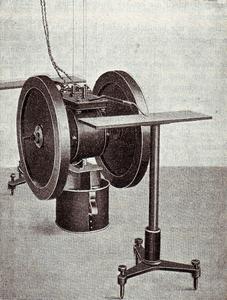
Föppl's experiment
Einstein too was powerfully influenced by Mach's thinking, and he originally listed Mach's principle as one of the three pillars of his general theory of relativity in 1918. Subsequently, however, it became clear that general relativity is at best only partly "Machian", and Einstein's interest faded. In 1954 he wrote to a colleague: "As a matter of fact, one should no longer speak of Mach's principle at all". (For his part Mach's initial enthusiasm for Einstein's work also waned, and he wrote in 1913: "I must ... assuredly disclaim to be a forerunner of the relativists".)
Experiments like Gravity Probe B should not be seen as tests of Mach's principle (which is ill-defined as it stands), but rather as tests of specific theories of gravity (which may or may not incorporate well-defined "Machian" features such as frame-dragging). Nevertheless, it is possible to think of Gravity Probe B as a modern-day realization of Newton's bucket experiment in which the rotating "vessel" is as large and massive as our planet, and the role of the water's surface is played by orbiting gyroscopes over a million times more sensitive than the best inertial navigation gyros on earth.
James Overduin, October 2007
Einstein's Spacetime (Next) ->
